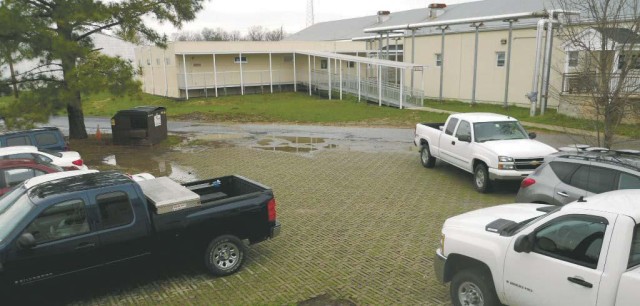ABERDEEN PROVING GROUND, Md. - The next time someone asks you to put a LID on it, don't take offense.
They may simply be asking whether you've considered putting a green roof on that new building you are designing. Low Impact Development, known as LID, is essentially a management approach using special landscaping techniques and small-scale green technologies to slow, filter and absorb stormwater.
The overarching objective is to keep a construction site as close to natural, predevelopment
conditions as possible. Protecting the natural water balance or hydrology of a site protects the overall watershed. Congress has required federal agencies to provide national leadership to reduce
water quality problems from stormwater runoff under the "Energy Independence and Security Act of 2007."
By 2013, all military projects must incorporate LID technologies "to make water go up or down, instead of horizontally," according to Todd Beser of the Chesapeake Bay Team, USAG Aberdeen
Proving Ground Department of Public Works.
Stormwater runoff in urban areas is one of the leading sources of water pollution in the United States. Impervious surfaces like paved parking lots and concrete walk ways do not allow stormwater to slowly soak into the ground, becoming cleaner in the process. Instead, this runoff
picks up sediment and pollutants like nitrogen and phosphorus and flows into storm drains that dump directly into the Bay, disrupting the sensitive ecosystem.
Examples of LID techniques include establishing rain gardens, installing bioretention cells and infiltration planters, planting grassed swales, trees, and pocket wetlands up to a half-acre in size, and other revegetation efforts that use native plants and grasses when possible. Porous pavements also serve to slow the rate of runoff and increase water infiltration into the ground. Rain cisterns can capture rainwater to reuse for other purposes.
The Chesapeake Bay Team has recently partnered with Army Research Laboratory and the Army Test Center to take the lead on LID. Two projects have been chosen and centrally funded by the Office of the Assistant Chief of Staff for Installation Management as demonstration/pilot areas and are at 30 percent design phase, according to Chesapeake Bay Team Leader Steve Wampler.
The first test site is the ARL design and construction of a 475' x 75' unmanned aerial vehicle airfield on Spesutie Island. The second pilot project is retrofitting the entryway for ATC Building 400 by removing curbs and asphalt and replacing them with bioretention cells and permeable parking pavers.
"APG is getting rid of large stormwater management ponds and looking more at localized techniques such as grassed swales and rain gardens [in construction projects]," said Wampler.
The driving force behind LID is to show new natural ways to manage stormwater at costs comparable to traditional engineering, while saving space and utilizing water more efficiently. Another added benefit of LID is that these changes are pleasing to the senses; they look attractive and often provide shade, breaking up vast expanses of pavement.
APG is home to two of the three healthiest and cleanest tributaries in the entire Bay region. In order to maintain this high water quality and keep moving forward, Wampler stressed that early,
smart master planning is critical to LID success at APG and military installations nationwide.
"In the past, planning has not always considered the cumulative ecological impacts resulting from impervious surfaces in urban development that is an inevitable component of a changing and expanding military mission," Wampler emphasized.
Another member of the team, Rosemary Queen, thinks that it is time for a paradigm shift in our way of thinking-- that "LID should be an everyday practice in our construction projects in order to sustain our lands and help restore the Bay."
"If Army installations are truly to be sustainable, a systemic change must occur in stormwater management-a commitment to LID principles in the installation-wide visioning and planning processes integrated into the design of specific site planning actions," said Queen.
For more detailed information on these projects, LID techniques, and regulations governing the LID
requirement, visit the APG Blog at http://apg.armylive.dodlive.mil/).


Social Sharing